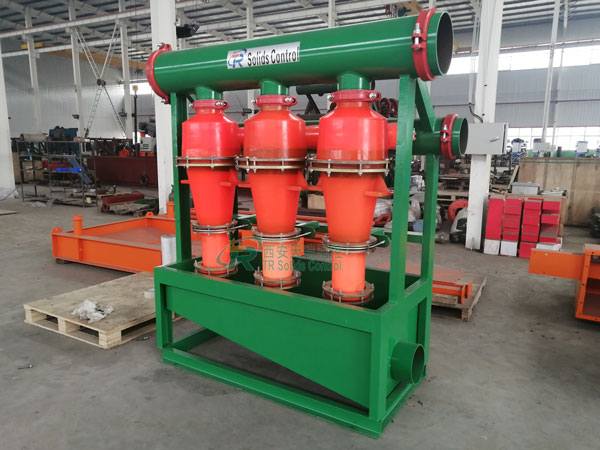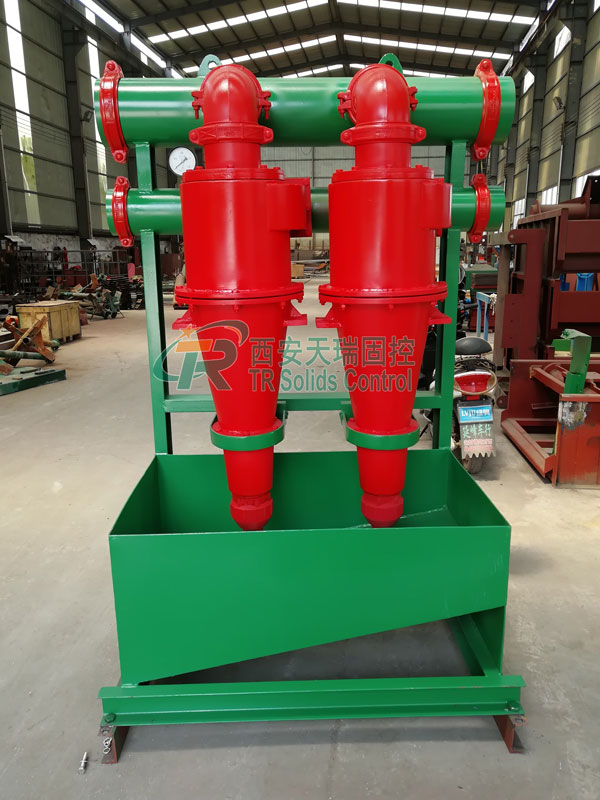Mud desanders are core equipment for separating sand particles (40-75μm) from mud in drilling, pile foundation, and shield tunneling projects. Their selection directly impacts mud performance, project efficiency, and equipment life. Desander cyclones utilize the principle of cyclonic flow to generate centrifugal force to separate solid particles, thereby purifying the drilling fluid and preventing large particles from abrading drill tools.

Equipment Capacity Adaptation
The desander's approved capacity must be at least 125% of the maximum displacement during drilling. For example, if the drilling pump's maximum displacement is 160 m³/h, the desander's capacity should be at least 200 m³/h to ensure stable operation despite pump pressure fluctuations or increased displacement.
Advantages of Multi-Cyclone Combinations
Combining multiple cyclones (e.g., 4-6 in parallel) allows for flexible adjustment of processing capacity. For example, a single cyclone with a processing capacity of 50 m³/h can reach a total capacity of 200 m³/h by connecting four cyclones in parallel. Separation efficiency is also improved (due to dispersed slurry processing, reducing the risk of cyclone overload).
Relationship between cyclone diameter and separation efficiency
An efficient desander must be able to separate solid particles between 45 and 75 microns, the primary size range of sand particles in drilling fluid.
Small-diameter cyclones (e.g., 150 mm): Offer high separation accuracy and can remove finer particles, but with lower throughput, making them suitable for delicate operations.
Large-diameter cyclones (e.g., 300 mm): Offer high throughput but relatively lower separation accuracy, making them suitable for high-flow, low-precision applications.
Recommendation: Selection should be based on drilling conditions. Small-diameter cyclones are preferred for complex formations (e.g., soft mudstone and gravel layers); large-diameter cyclones can be used to reduce costs in simple formations.
| Material type | Applicable scenarios | Advantages | Things to note |
| Wear-resistant cast iron | Conventional drilling fluid (low corrosion, low wear) | Low cost and easy processing | Avoid contact with high salt/acidic mud |
| High chromium alloy | Drilling fluid containing highly abrasive particles such as quartz sand | High hardness, lifespan increased by 3 times | It is heavy and requires a stable base |
| Polyurethane | Corrosive mud (such as WBM, BOM) | Corrosion-resistant, lightweight, shock-absorbing and noise-reducing | Avoid prolonged high temperatures |
Recommendation: In working conditions with high sand hardness and rapid wear (such as deep oil and gas fields), high chromium cast iron is preferred; in scenarios with strong corrosion or requiring rapid replacement, polyurethane is preferred.

Structural Design: Balances efficiency and ease of maintenance.
Multi-cyclone parallel design: A single unit can be equipped with 2-6 cyclones, increasing throughput and facilitating single-unit maintenance, avoiding downtime.
Sand Discharge Port Design: An "automatic sand discharge valve + anti-clogging channel" design is preferred to reduce manual sand removal.
Base and Vibration Damping: A non-slip and anti-vibration base is required, especially on mobile drilling platforms (such as truck-mounted rigs) to prevent feed deviation caused by equipment movement.
Underflow Screenless Type
Advantages: Simple structure, low maintenance cost, suitable for applications with small processing volumes and low precision requirements.
Disadvantages: Separated solids are discharged directly, potentially carrying a small amount of drilling fluid, resulting in reduced utilization.
Underflow Screen Type
Advantages: Drilling fluid is recovered from solids through an underflow screen, improving utilization. Suitable for high-cost drilling fluids or applications with strict environmental requirements.
Disadvantages: Complex structure and high cost.
Recommendation: The underflow screen type is preferred in areas with high drilling fluid costs (such as oil-based drilling fluids) or strict environmental requirements (such as offshore drilling).
Automated Control Functions
Required: Automatic feed pressure monitoring (optimal pressure 0.2-0.4 MPa, with overpressure alarm), automatic mud level adjustment (to prevent overflow discharge).
Preferred: A PLC control system that can be linked with the drilling platform's master control system to automatically adjust the processing mode based on mud sand content.
Expanded Operating Condition Adaptability
For low-temperature environments (such as permafrost areas), select a model with a mud preheating jacket to prevent mud freezing and clogging the cyclone.
For offshore drilling, a sealed structure that is resistant to salt spray corrosion and a motor protection rating of at least IP54 is required.
In a deep oil and gas field drilling project, complex formations resulted in drilling fluid sand content reaching 15% (normally <5%), a 30% increase in pump pressure, and increased drill bit wear. After introducing a high-performance desander (a small-diameter polyurethane cyclone with an underflow screen structure):
Separation efficiency reached 92% (removing over 95% of particles 74 microns and over 50% of particles 40 microns);
Drilling fluid density was reduced from 1.8 g/cm³ to 1.5 g/cm³, and viscosity was reduced from 65s to 45s;
Drilling efficiency increased by 35%, drill bit life doubled, and the cost per well was significantly reduced.
| Dimensions | core indicators |
|---|---|
| Separation particle size | Covering 45-75 microns, choose a small diameter cyclone for complex formations and a large diameter cyclone for simple formations |
| Throughput | Permitted processing capacity ≥ 125% of the maximum displacement of the drilling pump; multiple cyclones in parallel to improve flexibility |
| Material | The cyclone is made of high chromium cast iron (high hardness sand) or polyurethane (corrosion resistant/quick replacement), and the vibration screening is made of stainless steel |
| Structure type | For high-cost drilling fluid or high environmental protection requirements, choose the underflow screen type; for other scenarios, choose the non-underflow screen type |
| Intelligent | Optional IoT sensors and automatic recoil function for real-time monitoring and control |
| cost balance | Comprehensively evaluate procurement, operation, and maintenance costs to select equipment with the highest life cycle benefits |
The above considerations for selecting a mud desander can significantly improve drilling fluid performance, reduce equipment wear and drilling costs, and meet environmental protection requirements. Tianrui Solids Control can customize different desander cyclones based on customer needs and deliver them to customers after commissioning them to meet standards. For inquiries, please contact: 13186019231.

Address: No.2 Hu·ochang Rood, Yangling District, Xianyang City, Shaanxi Province, China
Tel: +86-13186019379
Wechat: 18509252400
Email: info@mudsolidscontrol.com
Contact: Mr.Li